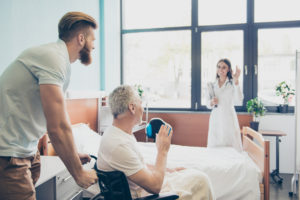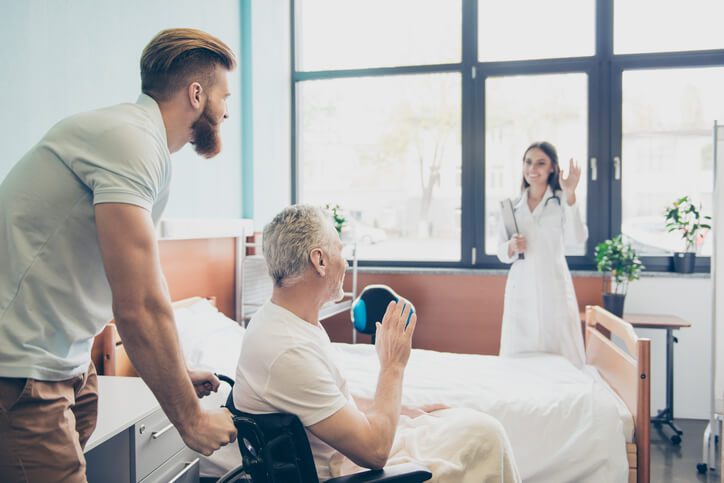All patients have different needs – how can you ensure the best possible outcome for each individual? “The truth is, patients are more alike than they are different,” says Sarah K. Mondano, Director of Musculoskeletal Services at Indian River Medical Center. “One of the beauties of standardized care is that 95% of the care happens automatically, and the 5% that’s left is really customized for that patient.”
At the 2018 Musculoskeletal Leadership Summit, Mondano shared key tactics for improving the experience, outcomes,
and value of the total joint replacement program at Indian River Medical Center. In part one of this series, we looked at the ways Mondano and her team optimized patients pre-operatively to reduce variation across the continuum of care. Next, we’ll share the strategies used when implementing post-acute pathways at IRMC to establish a patient-focused experience.
Acute Care Redesign
The goal in the Acute Care phase of the patient experience at IRMC was to achieve effective patient management post-discharge. This was accomplished through the following steps:
- Revamp inpatient order sets. When Mondano joined the team at IRMC two years ago, they had 17 or 18 different post-op order sets for hips and knees. The team changed the management approach to multimodal – a method that was physician driven. It took a couple of years to achieve, but their inpatient order sets are now down to one.
- Increase patient comfort to prepare for early mobilization. When assessing post-operative medications, the team at IRMC worked with anesthesia to research the most effective combination of pre-op, inter-op and post-op cocktails. They also piloted the use of nerve blocks. The goal of these changes was to increase patient comfort so they could mobilize patients and begin the rehab process on the day of surgery.
- Improve nursing communication protocols. We know the biggest driver of HCAHPS is nurse communication. The nurses and therapists on the floor at IRMC came up with educational printouts that are posted in each room, within reach of the patient. This is just another vehicle for communicating consistent messaging surrounding patient expectations across the care pathway.
- Consider involvement of hospitalists. The hospitalist program attends to about 85% of the patients at IRMC. The orthopedic unit was the first to trial having dedicated hospitalists on the unit. “It’s made a huge impact,” says Mondano. “The hospitalists get to know the nurses, they know the surgeon’s protocols, and they know the therapists. It’s a well-oiled machine.”
Post-Acute Care Redesign
Managing patients post-discharge is really the key to ensuring a successful recovery. IRMC’s goal in the post-acute phase of the continuum of care was to achieve effective patient management post-charge, as mentioned, as well as monitoring outcomes and cost. Here’s how:
- Collaborate with post-acute providers to revise and standardize pathways. IRMC brought post-acute providers together to establish PAC report cards and create standardized care plans not just for patients going home with Home Health, but also for when they went to a skilled nursing facility. Their length of stay at a skilled facility decreased from about 50 to 60 days to about 10 days.
- Host regular post-acute provider meetings. In order for this to become a collaborative process, it was important to IRMC that the post-acute providers meet on a quarterly basis. They conducted skills fairs and competency to look closely at what is going on with the patients and provide ongoing education throughout the episode of care.
- Encourage electronic communication between the navigator and post-acute providers. The web-based platform IRMC chose is bi-directional. When a patient leaves the hospital, the post-acute provider tracks their progress through digital scorecards. All of this information then comes back to the navigator. This allows them to hold post-acute providers accountable for quality outcomes.
Measuring Success
CJR began at IRMC in 2016, and at the time, they were over their target prices. Now, they’re balancing quality and balancing cost, and this is largely driven by the initiatives put in place with the post-acute providers. “We still had the same outcomes, but we were very cognizant of the cost,” Mondano says.
When considering factors such as communication with nurses, the responsiveness of hospital staff, pain management and the overall rating of the hospital, Mondano explains that IRMC has made significant gains. Not only has their average length of stay dropped since 2016, but their readmission rate is now below 1%. By implementing patients pre-operatively and applying standardized post-acute pathways, IRMC increased the utilization of Home Health.
“As the care improvement team at Indian River has shown, a procedure like total joint replacement can always be optimized to provide better patient outcomes and a more efficient process,” says Mondano. “Total joint replacement patients at Indian River now experience what I call a true patient experience.”







